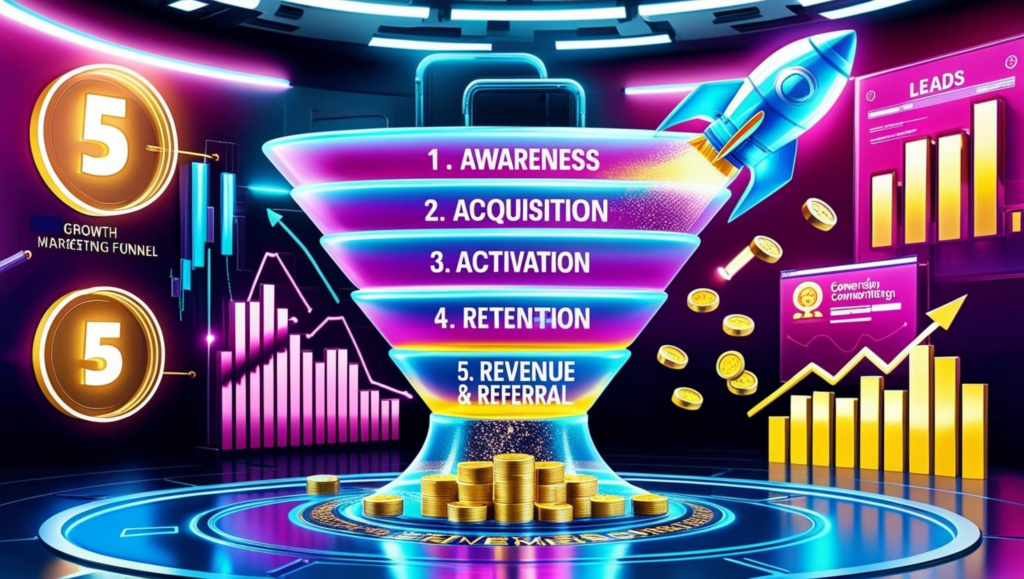Introduction
In today’s competitive digital landscape, businesses need more than just traditional marketing; they need a growth marketing funnel. Unlike conventional funnels that focus solely on acquisition, a growth hacking funnel leverages data-driven strategies to optimize every stage of the customer journey, from awareness to retention.
Whether you’re a startup looking to scale or a SaaS company aiming for sustainable growth, this guide will walk you through how to build a marketing funnel that drives conversions, engagement, and long-term success.
A growth marketing funnel also called sales or conversion funnel is a 5-stage system (awareness → revenue) that optimizes conversions at scale using data and automation.
Why Growth Marketing Funnels Matter
A growth marketing funnel is a strategic framework designed to attract, engage, convert, and retain customers through continuous experimentation and optimization. Unlike traditional marketing funnels, growth marketing focuses on rapid experimentation, data analysis, and iterative improvements to maximize ROI.
Key Stages of a Growth Marketing Funnel
Turn leads into paying customers through onboarding and personalized experiences.
1. Awareness (Top of Funnel – TOFU)
- Attract potential customers through SEO, content marketing, paid ads, and social media.
- Example: Blog posts, infographics, and viral social campaigns.
2. Acquisition (Middle of Funnel – MOFU)
- Capture leads via email signups, free trials, or lead magnets.
- Example: Webinars, eBooks, and demo requests.
3. Activation (Conversion)
- Turn leads into paying customers through onboarding and personalized experiences.
- Example: SaaS free trials with guided tutorials.
4. Retention (Bottom of Funnel – BOFU)
- Keep customers engaged with loyalty programs, email nurturing, and exceptional support.
- Example: Exclusive discounts for repeat buyers.
5. Referral & Revenue Expansion
- Encourage word-of-mouth marketing and upsell opportunities.
- Example: Referral programs and premium feature upgrades.
Why a Growth Funnel Strategy is Essential for Startups
For startups, a marketing funnel for startups is critical because:
✔ Cost-Effective Scaling – Focuses on high-impact, low-cost growth tactics.
✔ Data-Driven Decisions – Uses A/B testing and analytics to refine strategies.
✔ Faster Iteration – Quickly adapts to market changes and customer feedback.
Example: Dropbox’s referral program (a classic growth hacking funnel tactic) helped them grow exponentially by incentivizing users to invite friends.
“Startups using this growth funnel strategy see 3-5x higher conversions than traditional funnels”
(HubSpot, 2024).
Growth Hacking Funnel vs Traditional Funnel
A growth hacking funnel is experimental, agile, and metrics-driven. Traditional funnels rely on fixed stages and slow feedback loops. Growth hackers test bold ideas fast, fail fast, and scale what works.
| Feature | Traditional Funnel | Growth Hacking Funnel |
|---|---|---|
| Focus | Awareness & Sales | Full Lifecycle Growth |
| Methodology | Fixed Campaigns | Agile Experimentation |
| Tools | CRMs, Ads | A/B Testing, Analytics |
How to Build a High-Converting Growth Marketing Funnel
Step 1: Define Your Target Audience
- Use customer personas and market research.
- Tools: Google Analytics, Hotjar, surveys.
Step 2: Optimize Top-of-Funnel (TOFU) for Awareness
- Create SEO-optimized content targeting sales funnel keywords.
- Leverage paid ads (Google Ads, LinkedIn, Facebook).
Step 3: Capture Leads with Middle-of-Funnel (MOFU) Strategies
- Use email marketing to nurture leads.
- Offer lead magnets (checklists, free trials, templates).
Step 4: Boost Conversions with Bottom-of-Funnel (BOFU) Tactics
- Implement retargeting ads for cart abandoners.
- Offer limited-time discounts or bonuses.
Step 5: Retain & Expand Revenue
- Use email drip campaigns for onboarding.
- Upsell/cross-sell existing customers.
Growth Marketing for SaaS: Special Considerations
SaaS companies need a tailored sales marketing funnel because:
- Free Trials & Freemium Models – Drive activation through seamless onboarding.
- Churn Reduction – Focus on customer success and engagement.
- Scalable Automation – Use tools like HubSpot, Intercom, and Mixpanel.
Example: Slack’s viral growth was fueled by seamless team onboarding and integrations.
Common Growth Funnel Mistakes to Avoid
❌ Ignoring Data – Not tracking KPIs like CAC, LTV, and churn rate.
❌ Overlooking Retention – Focusing only on acquisition.
❌ Poor Onboarding – Complicated signup processes increase drop-offs.
Key Tools for Optimizing Your Growth Funnel
- Analytics: Google Analytics, Mixpanel
- Email Marketing: Mailchimp, ActiveCampaign
- A/B Testing: Optimizely, VWO
- CRM: HubSpot, Salesforce
Conclusion: Mastering the Growth Marketing Funnel
A well-structured sales funnel is the backbone of scalable, sustainable growth. By focusing on data-driven experimentation, customer retention, and continuous optimization, businesses especially startups and SaaS companies can achieve explosive growth.
Ready to build your funnel? Start by mapping your customer journey, testing strategies, and refining based on performance data.
FAQs
Q1: What is a growth marketing funnel?
Ans: A growth marketing funnel is a data-driven framework that optimizes customer acquisition, activation, retention, and revenue expansion through continuous experimentation.
Q2: How is a growth hacking funnel different from a traditional funnel?
Ans: A growth hacking funnel prioritizes rapid experimentation and scalability, while traditional funnels focus on linear customer journeys.
Q3: What’s the best growth funnel strategy for SaaS?
Ans: Focus on free trials, seamless onboarding, and reducing churn through customer
